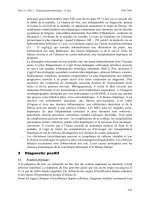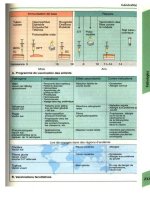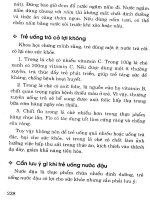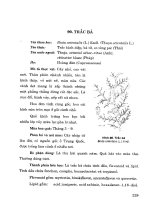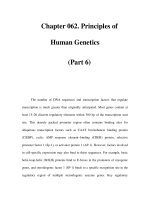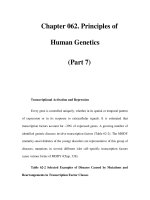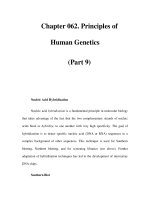BASIC HUMAN ANATOMY - PART 9 potx
Bạn đang xem bản rút gọn của tài liệu. Xem và tải ngay bản đầy đủ của tài liệu tại đây (358.41 KB, 25 trang )
MD0006 11-16
(1) Cranial nerves. The 12 pairs of nerves attached to the right and left
sides of the brainstem are called cranial nerves. Each cranial nerve is identified by a
Roman numeral in order from I to XII and an individual name. For example, the Vth
("fifth") cranial nerve is known as the trigeminal nerve (N.).
TRI = three
GEMINI = alike
TRIGEMINAL = having three similar major branches
(2) Spinal nerves. Attached to the sides of the spinal cord are 31 pairs of
spinal nerves. The spinal nerves are named by:
(a) The region of the spinal cord with which the nerve is associated.
(b) An Arabic numeral within the region. For example, T-5 is the fifth
spinal nerve in the thoracic region.
11-15. A "TYPICAL" SPINAL NERVE
In the human body, every spinal nerve has essentially the same construction
and components. By learning the anatomy of one spinal nerve, you can understand the
anatomy of all spinal nerves.
a. Parts of a "Typical" Spinal Nerve (figure 11-8). Like a tree, a typical
spinal nerve has roots, a trunk, and branches (rami).
Figure 11-8. A "typical" spinal nerve with a cross section of the spinal cord.
MD0006 11-17
(1) Coming off of the posterior and anterior sides of the spinal cord are the
posterior (dorsal) and anterior (ventral) roots of the spinal nerve. An enlargement on
the posterior root is the posterior root ganglion. A ganglion is a collection of neuron cell
bodies, together, outside the CNS.
(2) Laterally, the posterior and anterior roots of the spinal nerve join to form
the spinal nerve trunk. The spinal nerve trunk of each spinal nerve is located in the
appropriate intervertebral foramen of the vertebral column. (An intervertebral foramen
is a passage formed on either side of the junction between two vertebrae.)
(3) Where the spinal nerve trunk emerges laterally from the intervertebral
foramen, the trunk divides into two major branches. These branches are called the
anterior (ventral) and posterior (dorsal) primary rami (ramus, singular). The posterior
primary rami go to the back. The anterior primary rami go to the sides and front of the
body and also to the upper and lower members.
b. Neurons of a "Typical" Spinal Nerve. A nerve is defined above as a
collection of neuron processes. Thus, neuron processes are the components that make
up a nerve. These processes may belong to any of several different types of
neurons: afferent (sensory), efferent (motor), and visceral motor neurons of the ANS.
(1) The afferent neuron and the efferent neuron are the two types we will
consider here. An afferent neuron is one which carries information from the periphery to
the CNS.
A = toward
FERENT = to carry
An efferent neuron is one which carries information from the CNS to a muscle or gland.
E = away from
FERENT = to carry
(2) The afferent neuron is often called the sensory neuron because it carries
information about the senses to the CNS. The efferent neuron is often called the motor
neuron because it carries commands from the CNS to cause a muscle to act.
(3) A stimulus acts upon a sensory receptor organ in the skin or in another
part of the body. The information is carried by an afferent (sensory) neuron through
merging branches of the spinal nerve to the posterior root ganglion. The afferent
(sensory) neuron's cell body is located in the posterior root ganglion. From this point,
information continues in the posterior root to the spinal cord. The efferent (motor)
neuron carries command information from the spinal cord to the individual muscle of the
human body.
MD0006 11-18
(4) Visceral motor neurons of the ANS (see section V), which innervate
visceral organs of the body's periphery, are distributed along with the peripheral nerves.
c. The General Reflex Arc (figure 11-9).
Figure 11-9. The general reflex arc.
(1) Definitions.
(a) An automatic reaction to a stimulus (without first having conscious
sensation) is referred to as a reflex. (As an example: The withdrawal of the hand from
a hot object.)
(b) The pathway from the receptor organ to the reacting muscle is
called the reflex arc.
(2) Components of the general reflex arc. The pathway of a general reflex
arc involves a minimum of five structures.
(a) The stimulus is received by a receptor organ.
(b) That information is transmitted to the CNS by the afferent (sensory)
neuron.
MD0006 11-19
(c) Within the spinal cord, there is a special neuron connecting the
afferent neuron to the efferent neuron. This special connecting neuron is called the
internuncial neuron, or interneuron.
INTER = between
NUNCIA = messenger
INTERNUNCIAL = the carrier of information between
(d) The efferent (motor) neuron carries the appropriate command from
the spinal cord to the reacting muscle.
(e) The reacting muscle is called the effector organ.
Section V. THE AUTONOMIC NERVOUS SYSTEM (ANS)
11-16. GENERAL
The autonomic nervous system (ANS) is that portion of the nervous system
generally concerned with commands for smooth muscle tissue, cardiac muscle tissue,
and glands.
a. Visceral Organs.
(1) Definition. The term visceral organs may be used to include:
(a) The various hollow organs of the body whose walls have smooth
muscle tissue in them. Examples are the blood vessels and the gut.
(b) The glands.
(2) Distribution. The visceral organs are located in the central cavity of the
body (example: stomach) and throughout the periphery of the body (example: sweat
glands of the skin).
(3) Control. It has always been thought that the control of visceral organs
was "automatic" and not conscious. However, recent researches indicate that proper
training enables a person to consciously control some of the visceral organs.
b. Efferent Pathways. Earlier, we said that each neuron in the PNS extended
the entire distance from the CNS to the receptor or effector organ. In the ANS, there
are always two neurons (one after the other) connecting the CNS with the visceral
MD0006 11-20
organ. The cell bodies of the second neurons form a collection outside the CNS, called
a ganglion.
(1) The first neuron extends from the CNS to the ganglion and is therefore
called the preganglionic neuron.
(2) Cell bodies of the second neuron make up the ganglion. The second
neuron's processes extend from the ganglion to the visceral organ. Thus, the second
neuron is called the post-ganglionic neuron.
c. Major Divisions of the Human ANS. The efferent pathways of the ANS fall
into two major divisions:
(1) The thoraco-lumbar outflow (sympathetic nervous system).
(2) The cranio-sacral outflow (parasympathetic nervous system).
d. Major Activities of the Human ANS.
(1) The ANS maintains visceral activities in a balanced or stable
state. This is called homeostasis.
(2) When subjected to stress, such as a threat, the body responds with the
"fight-or-flight reaction." That is, those activities of the body necessary for action in an
emergency are activated and those not necessary are deactivated. This is the primary
function of the sympathetic portion of the ANS.
11-17. THE THORACO-LUMBAR OUTFLOW (SYMPATHETIC NERVOUS SYSTEM)
a. Refer to paragraph 11-10b(2) which describes the H-shaped region of gray
matter in the cross section of the spinal cord. Imagine extending the cross link of the H
slightly to the left and right of the vertical arms; the extended ends would correspond to
the intermediolateral gray columns. Cell bodies of the first neurons of the sympathetic
NS make up those columns between the T-1 and L-2 levels of the spinal cord, a total of
14 levels. Here, we are speaking of preganglionic sympathetic neurons.
b. Cell bodies of the second neurons make up various sympathetic ganglia of
the body. These ganglia include the trunk or chain ganglia and the pre-aortic or
"central" ganglia. Here, we are speaking of post- ganglionic sympathetic neurons.
c. The sympathetic NS innervates:
(1) Peripheral visceral organs (example: sweat glands).
(2) Central visceral organs (examples: lungs and stomach).
MD0006 11-21
d. The neurons innervating the peripheral visceral organs are distributed to
them by being included in the nerves of the PNS.
e. The sympathetic NS activates those visceral organs needed to mobilize
energy for action (example: heart) and deactivates those not needed (example: gut).
11-18. THE CRANIO-SACRAL OUTFLOW (PARASYMPATHETIC NERVOUS
SYSTEM)
a. Cell bodies of the first neurons of the parasympathetic NS make up the inter-
mediolateral gray columns in the sacral spinal cord at the S-2, S-3, and S-4 levels. See
paragraph 11-17a above for the position of the intermediolateral gray columns. Cell
bodies of the first neurons also make up four pairs of nuclei in the brainstem; these
nuclei are associated with cranial nerves III, VII, IX, and X. Here, we are speaking of
preganglionic parasympathetic neurons.
b. Cell bodies of the second neurons make up intramural ganglia within the
walls of the visceral organs. These second neurons innervate the central visceral
organs. They do NOT innervate peripheral visceral organs. Here, we are speaking of
the post-ganglionic parasympathetic neurons.
c. The parasympathetic NS has the opposite effect on visceral organs from that
of the sympathetic NS. (Example: The heart is accelerated by the sympathetic NS and
decelerated by the parasympathetic NS.)
Section VI. PATHWAYS OF THE HUMAN NERVOUS SYSTEM
11-19. GENERAL
a. Definitions.
(1) A pathway is the series of nervous structures utilized in the transmission
of an item of information. An example of a pathway is the reflex arc discussed in para-
graph 11-15c.
(2) The brainstem is continuous with the spinal cord. Together, the
brainstem and the spinal cord are sometimes known as the neuraxis.
b. General Categories of Neural Pathways.
(1) Sensory pathways. A sensory pathway is a series of nervous structures
used to transmit information from the body to the CNS. Upon arrival in the CNS, these
pathways ascend (go up) the neuraxis to the brain.
MD0006 11-22
(2) Motor pathways. A motor pathway is a series of nervous structures
used to transmit information from the CNS to the body. The commands for motor action
originate in the brain and descend (go down) the neuraxis to the appropriate spinal
levels. From this point, the commands pass through the nerves to the effector organs.
c. Controls. The human nervous system has several levels for control. The
lowest level is the simple reflex arc (see para 11-15c). The highest level of control is
the conscious level. From the lowest to the highest levels are several progressively
higher levels, such as the righting reflex. Thus, the processing of information and the
transmission of commands are not haphazard but very carefully monitored and
controlled. All information input and all information output are monitored and evaluated.
11-20. THE MOTOR PATHWAYS
Motor pathways begin in the brain. They descend the neuraxis in bundles of a
number of specific neuron processes called motor fiber tracts. Commands originating in
the right half of the brain leave the CNS through peripheral nerves on the left side.
Commands from the left half of the brain leave the CNS on the right side. Therefore,
the right half of the brain controls the left side of the body and the left half of the brain
controls the right side of the body. For example, the actions of the right hand are
controlled by the left half of the brain. (In those people who are right-handed, we refer
to the left half of the brain as being dominant.)
a. Pyramidal Motor Pathways. A pyramidal motor pathway is primarily con-
cerned with volitional (voluntary) control of the body parts, in particular the fine
movements of the hands. Because control is volitional, the pathways can be used for
neurological screening and testing. These pathways are called pyramidal because their
neuron processes contribute to the makeup of a pair of structures in the base of the
brain known as the pyramids.
b. Extrapyramidal Motor Pathways. An extrapyramidal pathway is primarily
concerned with automatic (nonvolitional) control of body parts for purposes of
coordination. Extrapyramidal pathways use many intermediate relays before reaching
the effector organs. The cerebellum of the brain plays a major role in extrapyramidal
pathways; the cerebellum helps to integrate patterned movements of the body.
11-21. THE SENSORY PATHWAYS
a. The body is continuously bombarded by types of information called stimuli
(stimulus, singular). Those few stimuli which are consciously perceived (in the cerebral
hemispheres) are called sensations.
b. Those stimuli received throughout the body are called the general senses.
Stimuli received by only single pairs of organs in the head (for example, the eyes) are
called special senses (for example, smell and taste).
MD0006 11-23
c. The general senses in humans include pain, temperature (warm and cold),
touch (light and deep), and proprioception ("body sense": posture, tone, tension).
d. The special senses in humans include smell (olfaction), taste (gustation),
vision, hearing (auditory), and equilibrium.
e. The input from each special sensory receptor goes to its own specific area of
the opposite cerebral hemisphere. The general sensory pathway is from the receptor
organ, via the PNS nerves, to the CNS. This general pathway then ascends fiber tracts
in the neuraxis. The pathway ends in the central area of the cerebral hemisphere (on
the side opposite to the input).
Section VII. THE SPECIAL SENSE OF SMELL (OLFACTION)
11-22. SENSORY RECEPTORS
Molecules of various materials are dispersed (spread) throughout the air we
breathe. A special olfactory epithelium is located in the upper recesses of the nasal
chambers in the head. Special hair cells in the olfactory epithelium are called chemore-
ceptors, because they receive these molecules in the air.
11-23. OLFACTORY SENSORY PATHWAY
The information received by the olfactory hair cells is transmitted by way of the
olfactory nerves (cranial nerves I). It passes through these nerves to the olfactory bulbs
and then into the opposite cerebral hemisphere. Here, the information becomes the
sensation of smell.
Section VIII. THE SPECIAL SENSE OF TASTE (GUSTATION)
11-24. SENSORY RECEPTORS
Molecules of various materials are also dispersed or dissolved in the fluids
(saliva) of the mouth. These molecules are from the food ingested (taken in). Organs
known as taste buds are scattered over the tongue and the rear of the mouth. Special
hair cells in the taste buds are chemoreceptors to react to these molecules.
11-25. SENSORY PATHWAY
The information received by the hair cells of the taste buds is transmitted to the
opposite side of the brain by way of three cranial nerves (VII, IX, and X). This
information is interpreted by the cerebral hemispheres as the sensation of taste.
MD0006 11-24
Section IX. THE SPECIAL SENSE OF VISION (SIGHT)
11-26. GENERAL
a. Stimulus. Rays of light stimulate the receptor tissues of the eyeballs (bulbus
oculi) to produce the special sense of vision. This includes both the sensation of vision
or seeing and a variety of reactions known as the light reflexes. The actual reception of
the light energy is a chemical reaction which in turn stimulates the neuron endings.
b. Optical Physics. To appreciate the functioning of the bulbus oculi, some
simple principles of optical physics must be understood.
(1) By means of a lens system, light rays are bent and brought to the focal
point for acute vision. This process is referred to as focusing.
(2) The focal length is the distance from the focal point to the center of the
lens. The amount of bending or focusing depends upon the exact curvatures of the lens
system.
c. Sense Organ. The eyeball is the special sense organ which contains the re-
ceptor tissues. The eyeball is suspended in the orbit. The orbit is a skeletal socket of
the skull which helps protect the eyeball. Various structures associated with the
functioning of the eyeball are called the adnexa. The adnexa include the eyelids, the
lacrimal system, etc.
11-27. THE EYEBALL (FIGURE 11-10)
a. Shape. In the main, the eyeball is a spherical bulb-like structure. Its anterior
surface, transparent and more curved, is known as the cornea of the eyeball.
b. Wall of the Eyeball. The eyeball is a hollow structure. Its wall is made up of
three layers known as coats or tunics.
(1) Sclera. The outermost layer is white and very dense FCT (fibrous
connective tissue). It is known as the sclera, scleral coat, or fibrous tunic. Its anterior
portion is called the cornea. As already mentioned, the cornea is transparent and more
curved than the rest of the sclera. The fixed curvature of the cornea enables it to serve
as the major focusing device for the eyeball.
(2) Choroid. The middle layer of the wall of the eyeball is known as the
choroid, the choroid coat, or the vascular tunic. This layer is richly supplied with blood
vessels. It is also pigmented with a black material. The black color absorbs light rays
and prevents them from reflecting at random.
MD0006 11-25
Figure 11-10. A horizontal section of the eyeball.
(3) Retina. The inner layer of the wall of the eyeball is known as the retina,
retinal coat, or internal tunic. The actual photoreceptor elements are located in the
retina at the back and sides of the eyeball. These elements are the rods and cones.
They constitute the nervous portion of the retina. In the anterior part of the eyeball, the
retina continues as a nonnervous portion.
MD0006 11-26
c. Internal Structures of the Eyeball.
(1) The nervous retina.
(a) The photoreceptors of the nervous portion of the retina (figure
11-11) contain chemicals known as visual pigments (rhodopsin). The cones are more
concentrated in the center at the back of the eyeball. The cones can register colors and
are used for acute vision. However, cones require more intense light than do rods. The
rods are distributed more toward the sides of the nervous retina. Although the rods are
capable of registering less intense light, rods perceive only black and white.
Figure 11-11. Cellular detail of the retina.
MD0006 11-27
(b) If you look directly at an object, light from the object will fall in a
small depression of the retina called the fovea centralis. The fovea centralis is at the
posterior end of the eyeball, exactly opposite the centers of the cornea, pupil, and lens.
The fovea centralis is found in a small yellow area of the retina called the macula lutea.
The macula lutea is the area of the retina where vision is sharpest.
FOVEA = small depression
CENTRALIS = center
MACULA = spot
LUTEA = yellow
(c) Associated with the rods and cones are the beginnings of neurons of
the optic nerve. These neurons pass out of the eyeball at the posterior end (in a point
medial and superior to the fovea centralis). At the point of exit, there are no rods or
cones. Therefore, it is called the blind spot (optic disc).
(2) Ciliary body. The anterior end of the choroid layer thickens to form a
circular "picture frame" around the lens of the eyeball. This is also near the margin of
the base of the cornea. The framelike structure is called the ciliary body. It includes
mostly radial muscle fibers, which form the ciliary muscle.
(3) Ligaments. The lens is suspended in place by ligaments (fibers of the
ciliary zonule). These ligaments connect the margin (equator) of the lens with the ciliary
body.
(4) Lens. The lens is located in the center of the anterior of the eyeball, just
behind the cornea.
(a) The lens is biconvex. This means that it has two outwardly curved
surfaces. The anterior surface is flatter (less curved) than the posterior surface.
(b) The lens is transparent and elastic. (As one grows older, the lens
becomes less and less elastic.) The ligaments maintain a tension upon the lens. This
tension keeps the lens flatter and allows the lens to focus on distant objects. When the
ciliary muscle contracts, the tension on the lens is decreased. The decreased tension
allows the lens to thicken. The greater thickness increases the anterior curvature and
allows close objects to be seen clearly.
(c) The process of focusing the lens for viewing close objects clearly is
called accommodation. The process of accommodation is accompanied by a reduction
in the pupil size as well as a convergence of the two central lines of sight (axes of
eyeball).
MD0006 11-28
(5) Iris. Another structure formed from the anterior portion of the choroid
layer is the iris. The iris is located between the lens and the cornea.
(a) The pupil is the hole in the middle of the iris. The size of the pupil is
controlled by radial and circular muscles in the iris. The radial muscles are dilators.
The circular muscles are constrictors. By changing the size of the pupil, the iris controls
the amount of light entering the eyeball.
(b) The iris may have many different colors. The actual color is deter-
mined by multiple genes.
(6) Chambers. The space between the cornea and the lens is called the
anterior cavity. The space between the cornea and the iris is called the anterior
chamber. The space between the iris and the lens is called the posterior chamber (see
fig 11-10). Both chambers of the anterior cavity are filled with a fluid called the aqueous
humor. The aqueous humor is secreted into the chambers by the ciliary body. It drains
into the encircling canal of Schlemm, located in the angle between the cornea and the
iris. This angle is called the iridiocornealis angle.
(7) Vitreous body. Behind the lens is a jellylike material called the vitreous
body.
11-28. THE ORBIT
The orbit is the cavity in the upper facial skull which contains the eyeball and its
adnexa. The orbit is open anteriorly.
a. The floor of the orbit is generally horizontal. Its medial wall is generally
vertical and straight from front to back. Since the lateral wall and roof converge to the
rear, the orbit is a conelike cavity.
b. In the facial skull, the orbit is surrounded by a number of specific spaces.
Superiorly, the roof of the orbit is also the floor of the anterior cranial cavity, where the
frontal portion of the brain is. Just medial to the medial wall are the structures of the
nasal chamber. Inferiorly, the floor of the orbit is also the roof of the maxillary sinus.
Laterally, the wall of the orbit is the inner wall of the temporal fossa, a depression on
each side of the skull where a fan-shaped chewing muscle (temporalis M.) is attached.
11-29. THE ADNEXA
The adnexa are the various structures associated with the eyeball.
a. Extrinsic Ocular Muscles. Among the adnexa are the extrinsic ocular
muscles, which move the eyeball within the orbit. Each eyeball has associated with it
six muscles made up of striated muscle fibers.
MD0006 11-29
(1) Four recti. Four of these muscles are straight from the rear of the orbit
to the eyeball. They are therefore known as the recti muscles (RECTUS = straight).
Each name indicates the position of the muscles in relationship to the eyeball as
follows:
lateral rectus M. (on the outer side)
superior rectus M. (above)
medial rectus M. (on the inner side)
inferior rectus M. (below)
(2) Two obliques. Two muscles approach the eyeball from the medial side
and are known as the superior oblique and inferior oblique muscles.
b. Eyelids. Attached to the margins of the orbit, in front of the eyeball, are the
upper and lower eyelids (palpebra (Latin), blepharon (Greek)). These have muscles for
opening and closing the eyelids. The eyelashes (cilia) are special hairs of the eyelids
which help protect the eyeball. The margins of the eyelids have special oil to prevent
the loss of fluids from the area. The inner lining of the eyelids is continuous with the
conjunctiva, a membrane over the anterior surface of the eyeball.
c. Lacrimal Apparatus. The conjunctiva must be kept moist and clean at all
times. To do this, a lacrimal apparatus is associated with the eyelids. In the upper
outer corner of the orbit is a lacrimal gland, which secretes a lacrimal fluid (tears) into
the junction between the upper eyelid and the conjunctiva. By the motion of the eyeball
and the eyelids (blinking), this fluid is moved across the surface of the conjunctiva to the
medial inferior aspect. Here, the lacrimal fluid is collected and delivered into the nasal
chamber by the nasolacrimal duct.
d. Eyebrow. The eyebrow (supercilium) is a special group of hairs above the
orbit. The eyebrow serves to keep rain and sweat away from the eyeball.
e. Optic Nerve (Cranial Nerve II). Neurons carry information from the
photoreceptors of the nervous retina. They leave the eyeball at the blind spot. At the
optic nerve, or second cranial nerve, the neurons pass to the rear of the orbit. There,
the optic nerve exits through the optic canal into the cranial cavity. Beneath the brain,
the optic nerves from both sides join to form the optic chiasma, in which half of the
neurons from each optic nerve cross to the opposite side. From the optic chiasma, the
right and left optic tracts proceed to the brain proper.
MD0006 11-30
Section X. THE SPECIAL SENSE OF HEARING (AUDITORY)
11-30. GENERAL
The human ear serves two major special sensory functions hearing (auditory)
and equilibrium (balance). The stimulus for hearing is sound waves. The stimulus for
equilibrium is gravitational forces.
a. Methods of Sound Transmission. The sound stimulus is transmitted in a
variety of ways. Regardless of the actual transmission method, the sound stimulus is
unchanged. Sound may be transmitted as:
(1) Airborne waves. These airborne waves have frequency (pitch) and
amplitude (loudness or intensity).
(2) Mechanical oscillations (vibrations) of structures.
(3) Fluid-borne pressure pulses.
(4) Electrical impulses along the neurons to and in the brain.
b. Sections of the Human Ear (figure 11-12). The human ear has three major
parts. Each part serves a specific function in the transmission and reception of the
sound stimulus. The three parts are known as the external (outer) ear, the middle ear,
and the internal (inner) ear.
11-31. THE EXTERNAL EAR
The external ear begins on the outside of the head in the form of a
funnel-shaped auricle (pinna). Actually serving as a funnel, the auricle directs airborne
sound waves into the external auditory meatus. The external auditory meatus is a
tubular canal extending into the temporal portion of the skull.
11-32. THE MIDDLE EAR
a. Tympanic Membrane. At the inner end of the external auditory meatus is
the tympanic membrane. The tympanic membrane (eardrum) is a circular membrane
separating the external auditory meatus from the middle ear cavity. The tympanic
membrane vibrates (mechanically oscillates) in response to airborne sound waves.
b. Middle Ear Cavity. On the medial side of the tympanic membrane is the
middle ear cavity. The middle ear cavity is a space within the temporal bone.
MD0006 11-31
Figure 11-12. A frontal section of the human ear.
c. Auditory Ossicles. The auditory ossicles (OSSICLE = small bone) are
three very small bones which form a chain across the middle ear cavity. They join the
tympanic membrane with the medial wall of the middle ear cavity. In order, the ossicles
are named as follows: malleus, incus, and stapes. The malleus is attached to the
tympanic membrane. A sound stimulus is transmitted from the tympanic membrane to
the medial wall of the middle ear cavity by way of the ossicles. The ossicles vibrate
(mechanically oscillate) in response to the sound stimulus.
d. Auditory (Eustachian) Tube. The auditory tube is a passage connecting
the middle ear cavity with the nasopharynx. The auditory tube maintains equal air
pressure on the two sides of the tympanic membrane.
e. Association With Other Spaces. The middle ear cavity is associated with
other spaces in the skull. The thin roof of the middle ear cavity is the floor of part of the
cranial cavity. The middle ear cavity is continuous posteriorly with the mastoid air cells
via the antrum (an upper posterior recess of the middle ear cavity).
MD0006 11-32
11-33. THE INTERNAL EAR
a. Labyrinths (Figure 11-13).
Figure 11-13. The labyrinths of the internal ear.
(1) Bony labyrinth. The bony labyrinth (LABYRINTH = a maze) is a complex
cavity within the temporal bone. It has three semicircular canals, a vestibule (hallway),
and a snail-shaped cochlear portion.
(2) Membranous labyrinth. The membranous labyrinth is a hollow tubular
structure suspended within the bony labyrinth.
b. Fluids of the Internal Ear. The endolymph is a fluid filling the space within
the membranous labyrinth. The perilymph is a fluid filling the space between the
membranous labyrinth and the bony labyrinth. These fluids are continuously formed
and drained away.
ENDO = within
PERI = around
MD0006 11-33
c. The Cochlea. The cochlea is a spiral structure associated with hearing. It
has 2-1/2 turns. Its outer boundaries are formed by the snail- shaped portion of the
bony labyrinth.
(1) The central column or axis of the cochlea is called the modiolus.
Extending from this central column is a spiral shelf of bone called the spiral lamina. A
fibrous membrane called the basilar membrane (or basilar lamina) connects the spiral
lamina with the outer bony wall of the cochlea. The basilar membrane forms the floor of
the cochlear duct, the spiral portion of the membranous labyrinth. Within the cochlear
duct, there is a structure on the basilar membrane called the organ of Corti. The organ
of Corti has hairs which are the sensory receptors for the special sense of hearing.
LAMINA = thin plate
(2) Within the bony cochlea, the space above the cochlear duct is known as
the scala vestibuli and the space below is known as the scala tympani. (See figure 11-
14.) Since the scalae are joined at their apex, they form a continuous channel and the
connection between them is called the helicotrema.
(3) Between the scalae and the middle ear cavity are two windows.
(a) Fenestra vestibuli (oval window). Between the middle ear cavity and
the scala vestibuli is an oval window called the fenestra vestibuli. It is filled with the foot
plate of the stapes.
(b) Fenestra cochleae (round window). Between the middle ear cavity
and the scala tympani is a round window called the fenestra cochleae. It is covered or
closed by a membrane.
d. Transmission.
(1) The sound stimulus is transferred from the stapes to the perilymph of the
scala vestibuli. Here the stimulus is transmitted as a pressure pulse in the fluid.
(2) In response, the basilar membrane of the cochlea vibrates (mechanically
oscillates). Only selected portions of the basilar membrane vibrate at any one time,
depending on the frequency of the sound stimulus.
(3) The hair cells of the organ of Corti at that particular location are mecha-
nically stimulated. This stimulation is transferred to the neurons of the acoustic nerve
(cranial nerve VIIIa). The acoustic nerve passes out of the modiolus into the internal
auditory meatus of the temporal bone. From here, it enters into the cranial cavity and
goes to the brain.
MD0006 11-34
Figure 11-14. Diagram of the scalae.
MD0006 11-35
Section XI. THE SPECIAL SENSE OF EQUILIBRIUM (BALANCE)
11-34. GENERAL
a. Posture. Posture is the specific alinement of the body parts at any given
time. Humans can assume an infinite variety of postures. However, the truly erect
posture is unique to humans.
b. Equilibrium. Equilibrium is the state of balance of the body. An erect stand-
ing human has a highly unstable equilibrium and therefore can easily fall. Through a
variety of sensory inputs (visual, etc.) and postural reflexes, the body is maintained in its
erect posture.
c. Stimulus-Gravitational Forces. A primary sensory input for equilibrium
consists of gravitational forces. This input is received by the membranous labyrinth
within the internal ear. The gravitational forces are of two types: static, when the body
is standing still, and kinetic, when the body is moving in either linear (straight) or angular
directions.
d. Membranous Labyrinth. The specific portions of the membranous labyrinth
involved are the two sac-like structures the sacculus and the utriculus. Each of these
two structures has an area of special hair cells called the macula. In addition, there are
three semicircular ducts located within the osseous semicircular canals of the temporal
bone of the skull. Each semicircular duct has a crista, a little ridge of hair cells across
the axis of the duct.
e. "Body Sense." All of the various sensory inputs related to the maintenance
of equilibrium and posture are integrated within the brain as "body sense." Correct
information is sent to the muscles of the body by means of specific postural reflexes in
order to maintain the proper posture.
11-35. SACCULUS AND UTRICULUS
a. The sacculus and the utriculus are two sac-like portions of the membranous
labyrinth. They are filled with endolymph.
b. On the wall of each sac is a collection of special hair cells known as the
macula, which serves as a receptor organ for static and linear kinetic gravitational
forces. The saccular macula and the utricular macula are oriented at more or less right
angles to each other. For the pair of maculae in the membranous labyrinth of the right
side, there is a corresponding pair in the labyrinth of the left side. Information from all of
these maculae is sent into the brain for continuous sensing of the position of the head in
space.
MD0006 11-36
11-36. SEMICIRCULAR DUCTS (FIGURE 11-15)
Extending from and opening into the utriculus are three hollow structures called
the semicircular ducts. Since the utriculus completes the circle for each duct, the ducts
act as if they were complete circles.
Figure 11-15. Diagram of semicircular duct orientation.
a. Orientation. Two of the ducts are vertically oriented (one anterior and one
posterior). The third duct is essentially horizontal. The three ducts are all oriented at
right angles to each other. In addition, the three ducts of one membranous labyrinth are
matched or paired by the three ducts of the opposite membranous labyrinth.
b. Ampullae and Cristae. Each semicircular duct ends with an enlargement
where it opens into the utriculus. This enlargement or swelling is called an ampulla.
The crista is at a right angle to the axis of the duct. Movement of the endolymph within
the duct caused by movement of the head in space deforms (bends) the hairs of the
crista in specific directions. These are responses to linear and/or angular kinetic
gravitational forces.
MD0006 11-37
11-37. THE VESTIBULAR NERVE
The vestibular nerve (cranial nerve VIII) carries all this information from the
maculae and cristae to the brain. The vestibular and auditory nerves are contained in
the same fibrous sheath from the membranous labyrinth to the brain. Within the brain,
the vestibular and auditory nerves separate into different pathways.
Section XII. CONTROLS IN THE HUMAN NERVOUS SYSTEM
11-38. GENERAL CONCEPT
The human nervous system can be thought of as a series of steps or levels.
Each level is more complex than the level just below. No level is completely
overpowered by upper levels, but each level is controlled or guided by the next upper
level as it functions.
11-39. LEVELS OF CONTROL
a. Reflex Arc. The simplest and lowest level of control is the reflex arc (see
para 11-15c). The reflex arc operates essentially on the level of the sensory input.
b. Segmental Reflexes. Segmental reflexes produce a wider reaction to a
stimulus than the reflex arc. For this purpose, the nervous system is organized more
complexly. Thus, information spreads to a wider area of the CNS. We can observe a
greater reaction to the stimulus.
c. Medullary Hindbrain. In the hindbrainstem are to be found a number of
nuclei (collections of neuron cell bodies) which monitor and control the activities of the
visceral functions of the body, such as respiration, heartbeat, etc.
d. Reticular Formation. Within the substance of the brainstem is a diffuse
system called the reticular formation.
RETICULAR = network
This reticular formation has a facilitatory (excitatory) area and an inhibitory area. These
areas monitor and control general body functions, including sleep.
e. Thalamus. In the forebrainstem is a major collection of nuclei, all together
called the thalamus. The thalamus is a primary relay for information going to and from
the cerebrum and cerebellum. In the lowest animals, the thalamus represents the
highest level of nervous control.
MD0006 11-38
f. Cerebellum. The cerebellum has been greatly developed with many
functional subdivisions. All together, it is one of the most important integrators of motor
activity of the body.
g. Cerebrum. In humans, the highest level of nervous control is localized in the
cerebrum. It is at this level that conscious sensation and volitional motor activity are
localized. Even so, we can clearly designate three levels of control within the cerebrum:
(1) Visceral (vegetative) level. This level is concerned primarily with visceral
activities of the body as related to fight-or-flight, fear, and other emotions.
(2) Patterned (stereotyped) motor actions. Here, activities of the body are
standardized and repetitive in nature. An example of a stereo- typed pattern of muscle
activity would be the sequence of muscle actions involved in walking.
(3) Volitional level. The volitional level is the highest and newest level of
control. Here, unique, brand-new solutions can be created.
Continue with Exercises
MD0006 11-40
7. Each item below refers to the thickness of the myelin surrounding an axon.
Give the letter indicating the type of neuron.
a. Thickest: .
b. Medium: .
c. Thinnest: .
8. Each item below indicates the route over which impulses are transmitted.
Give the type of neuron corresponding to each route.
a. From receptor organs to the CNS: .
b. From the CNS to muscles and glands: .
c. From one neuron to another: .
9. What is meant by the term "continuity without contact" as related to neuron
"connections"?
10. What is a synapse?
An axon terminates in tiny branches. What is at the end of each branch?
Where is neurotransmitter stored?
What is the presynaptic membrane?
What is the synaptic cleft?
What is the postsynaptic membrane?
MD0006 11-41
11. What is a neuromuscular junction?
Compare the neuromuscular junction to a synapse.
12. The major divisions of the human nervous system are the _____________
nervous system ( ), the nervous system ( ), and the
nervous system ( ). The CNS is made up of the and
the .
13. The three major subdivisions of the human brain are the ,
the , and the .
What is the brainstem?
14. The cerebellum is a spherical mass of nervous tissue attached to and
covering the . Its three major parts are the and right
and left hemispheres. In addition, the cerebellum has three pairs of
stem-like connecting parts called . The outer cortex is composed of
matter, which is the s of neurons. More central is the
matter, which is the myelinated processes of .
The cerebellum is the primary / of motor actions of the body.
15. The cerebrum consists of two very much enlarged s
connected to each other by a special structure called the c c .
Each cerebral hemisphere is connected to the brainstem by a c p .
The surface of each cerebral hemisphere is subdivided into areas known as l .
The names of the four lobes are f , p , o , and t .
16. The space separating the two cerebral hemispheres is called the longitudinal
. The shallow grooves in the surface of the cerebrum are called .
The ridges outlined by the grooves are called .
17. The gray outer layer of each hemisphere is the .
Deeper within the cerebral hemispheres, the tissue is colored . The "gray
matter" represents the s of the neurons. The "white matter" represents
the .
